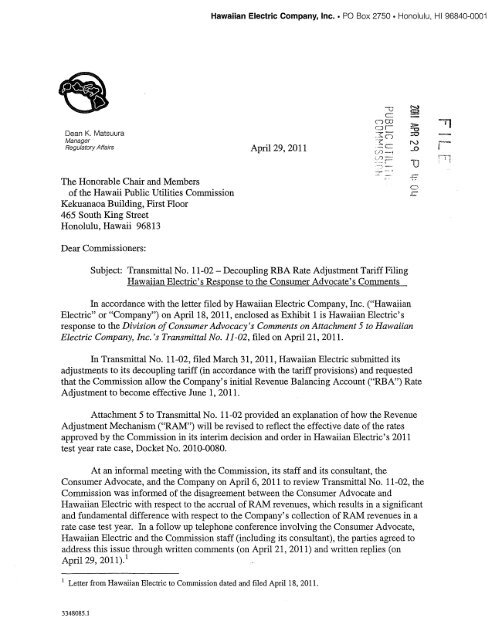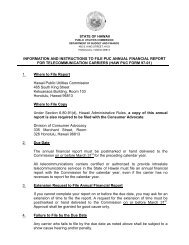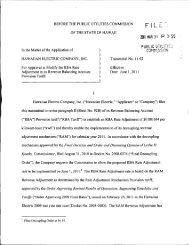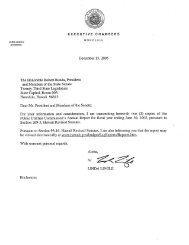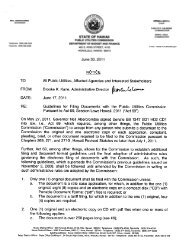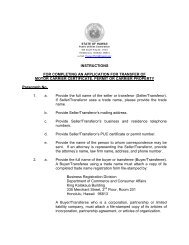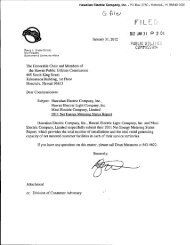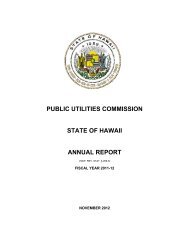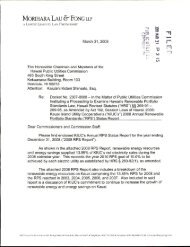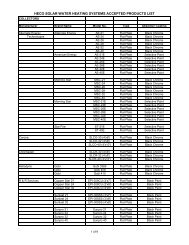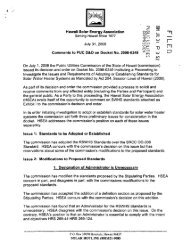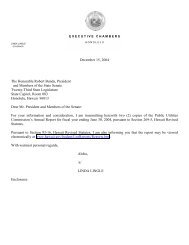HECO's Response to Consumer Advocate's Comments, 4/29/11
HECO's Response to Consumer Advocate's Comments, 4/29/11
HECO's Response to Consumer Advocate's Comments, 4/29/11
You also want an ePaper? Increase the reach of your titles
YUMPU automatically turns print PDFs into web optimized ePapers that Google loves.
Hawaiian Electric Company, Inc.• PO Box 2750. Honolulu, HI 96840-0001Dean K. MatsuuraManagerRegula<strong>to</strong>ry Affairs April <strong>29</strong>, 20<strong>11</strong>v c:(JCDC)r3:(=)'7'~c:(f)-j(./') r-The Honorable Chair and Membersof the Hawaii Public Utilities CommissionKekuanaoa Building, First Floor465 South King StreetHonolulu, Hawaii 96813Dear Commissioners:Subject: Transmittal No. <strong>11</strong>-02 - Decoupling RBA Rate Adjustment Tariff FilingHawaiian Electric's <strong>Response</strong> <strong>to</strong> the <strong>Consumer</strong> <strong>Advocate's</strong> <strong>Comments</strong>In accordance with the letter filed by Hawaiian Electric Company, Inc. ("HawaiianElectric" or "Company") on April 18, 20<strong>11</strong>, enclosed as Exhibit 1 is Hawaiian Electric'sresponse <strong>to</strong> the Division of<strong>Consumer</strong> Advocacy's <strong>Comments</strong> on Attachment 5 <strong>to</strong> HawaiianElectric Company, Inc. 's Transmittal No. <strong>11</strong>-02, filed on April 21, 20<strong>11</strong>.In Transmittal No. <strong>11</strong>-02, filed March 31, 20<strong>11</strong>, Hawaiian Electric submitted itsadjustments <strong>to</strong> its decoupling tariff (in accordance with the tariff provisions) and requestedthat the Commission allow the Company's initial Revenue Balancing Account ("RBA") RateAdjustment <strong>to</strong> become effective June 1, 20<strong>11</strong>.Attachment 5 <strong>to</strong> Transmittal No. <strong>11</strong>-02 provided an explanation of how the RevenueAdjustment Mechanism ("RAM") will be revised <strong>to</strong> reflect the effective date of the ratesapproved by the Commission in its interim decision and order in Hawaiian Electric's 20<strong>11</strong>test year rate case, Docket No. 2010-0080.At an informal meeting with the Commission, its staff and its consultant, the<strong>Consumer</strong> Advocate, and the Company on April 6, 20<strong>11</strong> <strong>to</strong> review Transmittal No. <strong>11</strong>-02, theCommission was informed of the disagreement between the <strong>Consumer</strong> Advocate andHawaiian Electric with respect <strong>to</strong> the accrual of RAM revenues, which results in a significantand fundamental difference with respect <strong>to</strong> the Company's collection of RAM revenues in arate case test year. In a follow up telephone conference involving the <strong>Consumer</strong> Advocate,Hawaiian Electric and the Commission staff (including its consultant), the parties agreed <strong>to</strong>address this issue through written comments (on April 21, 20<strong>11</strong>) and written replies (onApril <strong>29</strong>, 20<strong>11</strong>).<strong>11</strong> Letter from Hawaiian Electric <strong>to</strong> Commission dated and filed April 18, 20<strong>11</strong>.3348085.1
The Honorable Chair and Membersofthe Hawaii Public Utilities CommissionApril <strong>29</strong>, 2010Page 2<strong>Comments</strong> were filed by the <strong>Consumer</strong> Advocate and Hawaiian Electric on April 21,20<strong>11</strong>. Hawaiian Electric hereby transmits its response <strong>to</strong> the <strong>Consumer</strong> <strong>Advocate's</strong>comments.Hawaiian Electric appreciates the willingness of the <strong>Consumer</strong> Advocate and theCommission <strong>to</strong> address this significant issue, which is critical <strong>to</strong> the effective implementationof decoupling, in an expedited manner.Very truly yours,Dean K. MatsuuraManager, Regula<strong>to</strong>ry AffairsEnclosurecc:Division of <strong>Consumer</strong> AdvocacyDepartment of Defense
EXHIBIT 1PAGE 1 OF 19TRANSMITTAL NO. <strong>11</strong>-02HAWAIIAN ELECTRIC COMPANY, INC.RESPONSE TO CONSUMER ADVOCATE’S COMMENTS ON ATTACHMENT 51. The Company’s PositionHawaiian Electric Company, Inc.’s (“Hawaiian Electric” or “Company”) position is thatthe Rate Adjustment Mechanism (“RAM”) determines an incremental revenue amount for aspecific calendar year (or partial year, in the case of a rate case test year) that the Company isallowed <strong>to</strong> collect. In the case of the RAM tariff provision 1 , the determination of the amount ofrevenues <strong>to</strong> be collected is based on the adjusted revenue requirement for the current calendaryear. Collection of the annual RAM amount does not begin until June 1 st of the current year.Hawaiian Electric <strong>Comments</strong>, Exhibit 1, at 5.2. The <strong>Consumer</strong> Advocate’s PositionThe <strong>Consumer</strong> Advocate apparently does not view the RAM as an adjustment mechanismthat necessarily allows recovery of the revenue used <strong>to</strong> calculate the RAM. Rather, it apparentlyviews the RAM as merely setting a new rate, rather than a means <strong>to</strong> recover a certain level ofrevenue. Whether or not the Company recovers the intended revenue adjustment depends onwhether or not the interim rate order in a test year s<strong>to</strong>ps the collection process.3. The <strong>Consumer</strong> Advocate’s Position Would Result in Unreasonable, Unfair andUnintended ConsequencesAdoption of the <strong>Consumer</strong> Advocate’s position would result in unreasonable, unfair andseriously unintended consequences.First, there is the obvious impact in a rate case test year. A general rate increaseapplication can be filed on July 1, using the next calendar year or a test year. The Commission’s1 Hawaiian Electric Company, Inc. Tariff Sheets No. 93-93H, effective March 1, 20<strong>11</strong>.3357864.1
EXHIBIT 1PAGE 2 OF 19interim order is due within 10 months if a hearing has been held (or as of May 1 of the test yearfor an application filed on July 1 of the prior year), or within 10 months plus 30 days if a hearinghas not been held (or as of May 31 of the test year for an application filed on July 1 of the prioryear). Thus, in the case of a rate application filed on July 1 st , the RAM for the test year would becompletely nullified under the <strong>Consumer</strong> Advocate’s position, since it would be s<strong>to</strong>pped (May 1 s<strong>to</strong>r May 31 st ) even before it started (June 1 st ). Hawaiian Electric <strong>Comments</strong>, Exhibit 1, at 23-24.In addition, the “Commission may unilaterally discontinue the decoupling mechanism ifit finds that the public interest requires such action.” D&O, page 122. This power extends <strong>to</strong>both the RAM and the sales decoupling provisions. For example, the Commission could issue anorder on January 1, 2013 discontinuing decoupling. If the <strong>Consumer</strong> Advocate’s position isadopted, this order would be given retroactive effect by allowing recovery of, at most, 7/12ths ofthe RAM revenues attributable <strong>to</strong> 2012. Hawaiian Electric <strong>Comments</strong>, Exhibit 1, at 24.The Company’s position is that it should actually collect the revenue adjustment providedfor by the RAM. The <strong>Consumer</strong> Advocate’s position would effectively eliminate the recovery ofthe RAM adjustment in a test year4. The Company’s Position Is Supported by the Joint FSOPOn page 19 of its <strong>Comments</strong> on Attachment 5 <strong>to</strong> Hawaiian Electric Company, Inc.’sTransmittal No. <strong>11</strong>-02 (“<strong>Consumer</strong> Advocate <strong>Comments</strong>”), the <strong>Consumer</strong> Advocate states that“It is inappropriate and potentially misleading for HECO, in its Application at footnote 7, <strong>to</strong> nowimply that statements made by the <strong>Consumer</strong> Advocate in its earliest RAM ‘ConceptualFramework Proposal’ are now supportive of accrual accounting for RAM revenue increases as ofMarch 31 or any date prior <strong>to</strong> June 1.” The Company takes exception <strong>to</strong> this statement becausethe beginning bases of the discussions between the Company and the <strong>Consumer</strong> Advocate were3357864.1
EXHIBIT 1PAGE 3 OF 19each party’s proposal that was filed with the Commission on January 30, 2009. The January 30,2009 proposals identify the initial positions for each party, changes <strong>to</strong> which were the subject ofdiscussion and negotiation throughout the rest of the docket. Therefore, it was entirelyreasonable <strong>to</strong> use the proposals that were already filed with the Commission as a beginning basisfor discussions for a joint decoupling proposal even if they were the earliest RAM proposalsfiled by the Parties. To begin discussions ignoring what was already on the record isunreasonable.The <strong>Consumer</strong> Advocate does not deny that its initial proposal stated that “A HECORAM [that] shall be implemented <strong>to</strong> commence with a ‘base’ year 2009 and with authorizedrevenue changes effective on January 1, 2010 and again at January 1, 20<strong>11</strong>, but with thecorresponding rate adjustments delayed <strong>to</strong> May 1 of each year so that the established revenuevariance will be recovered over the subsequent eight months of the year.” See Division of<strong>Consumer</strong> Advocacy’s HECO/MECO/HELCO Rate Adjustment Mechanism “RAM”Conceptual Framework Proposal (“<strong>Consumer</strong> Advocate’s January 30, 2009 Proposal”), pages14-15. Notably, there is also nothing in the record that reflects that the <strong>Consumer</strong> Advocatewithdrew or modified its proposal (verbally or in writing) that authorized revenue changesshould start from the beginning of each calendar year following a test year (i.e., on January 1 ofeach year), even as the start date for the collection of the revenue variance and the period overwhich the revenue variance is collected changed over the course of the proceeding. 2Nor did the<strong>Consumer</strong> Advocate express at any point during negotiations between the <strong>Consumer</strong> Advocate2 The <strong>Consumer</strong> Advocate and Companies filed two joint statements of positions in the decoupling proceeding(Docket No. 2008-0274). The first was filed on March 30, 2009, titled “Joint Proposal on Decoupling andStatement of Position of the HECO Companies and the <strong>Consumer</strong> Advocate”. The second was filed on May <strong>11</strong>,2009, titled “Joint Final Statement of Position of the HECO Companies and <strong>Consumer</strong> Advocate” (“Joint FSOP”)which was approved by the Commission as part of the Amended Joint Proposal in the decoupling proceeding (FinalDecision and Order, filed August 31, 2010, pages 1-2).3357864.1
EXHIBIT 1PAGE 4 OF 19and the Company that the <strong>Consumer</strong> Advocate meant <strong>to</strong> withdraw or modify its initial proposalon when authorized revenue changes through the RAM would begin, or that there was a need <strong>to</strong>reflect such a change in the Exhibit C <strong>to</strong> the Joint FSOP 3 .As reflected in the Exhibit C, the proposals initially filed on January 30, 2009, were thebasis for discussions with columns that describe each party’s proposal and also reflect what thenegotiated agreement is in the “Agreement” column. For instance “Item A. Annual Filing Datefor Approval of RBA Adjustment rates <strong>to</strong> reflect Revenue Adjustments that Conform with theRAM Provision “on page 1 of Exhibit C reflects the Companies’ and <strong>Consumer</strong> Advocate’sbeginning positions and, on the far right, also reflects the negotiated agreement. 4For this item,the Agreement column states that “The parties agree <strong>to</strong> the <strong>Consumer</strong> Advocate’s proposal <strong>to</strong>allow use of actual recorded data for rate base calculations and depreciation and CIACamortization expense.” Changes or modifications from each party’s original January 30, 2009,proposal would have been described in Exhibit C.5. The Company’s Position Is Supported by the RAM TariffThe Company’s position is consistent with the language in the RAM Provision tariff,which spells out the mechanics for calculating the “RAM Revenue Adjustment”. The RAMRevenue Adjustment is “the difference between the calculated Authorized Base Revenue for theRAM Period and either: 1) the previous year’s calculated Authorized Base Revenue; or 2) therevenue requirement approved by the Commission in an interim or final decision in theCompany’s general rate case, whichever is more recent. The RAM Revenue Adjustmentdetermined by this RAM Provision is <strong>to</strong> be recovered through the RBA Provision commencing3 Exhibit C and Attachment 2 of Exhibit C were updated in the <strong>Consumer</strong> Advocate and Companies’ letter <strong>to</strong> theCommission, “Subject: Revised and New Exhibits for the Joint SOP”, dated June 25, 2009.4 The “Hawaiian Electric Companies” or “Companies” are Hawaiian Electric, Maui Electric Company, Limited(“MECO”) and Hawaii Electric Light Company, Inc. (“HELCO”)3357864.1
EXHIBIT 1PAGE 5 OF 19on June 1 and over the subsequent 12 months after June 1.” The RAM determines anincremental revenue amount for a specific calendar year (or partial year, in the case of a rate casetest year) that the Company is allowed <strong>to</strong> collect. The collection (or refund) period differs fromthe period used <strong>to</strong> determine the RAM revenues and the sales decoupling differential. HawaiianElectric <strong>Comments</strong>, Exhibit 1, at 5-6.RAM Calculations for a Test YearThe <strong>Consumer</strong> Advocate argues that “HECO provides no references in<strong>to</strong> the RBA orRAM tariffs or any materials filed in Docket No. 2008-0274 for this six step process or the dailyprorate calculations set forth therein. The <strong>Consumer</strong> Advocate submits that these calculationsare not supported by the record in the decoupling proceeding and are wholly unnecessary giventhe clearly defined effective dates for RAM revenue changes.” <strong>Consumer</strong> Advocate <strong>Comments</strong>at 10.However, the RAM tariff provisions do not address the collection of RAM Revenuesonce there is an interim rate order, other than <strong>to</strong> state that: “The RAM Revenue Adjustmentestablished for RAM Period calendar year that is also a rate case test year shall remain in effectuntil the Commission approves a base revenue level in the Company’s test year rate application.”.That would appear <strong>to</strong> be the reason that Commission staff and its consultant requested that theCompany address this in Attachment 5.Fundamentally, the <strong>Consumer</strong> Advocate relies on the fact that the RAM tariff only refers<strong>to</strong> the period over which revenues will be collected, and does not address the difference betweenthe period over which RAM revenues are accrued, and the period over which they are collected.This is the only “evidence” the <strong>Consumer</strong> Advocate points <strong>to</strong> in support of its position that theaccrual period and the collection period are the same.3357864.1
EXHIBIT 1PAGE 6 OF 19The short answer <strong>to</strong> this contention is that that is true of other surcharge provisions inHawaii. See <strong>Consumer</strong> Advocate <strong>Comments</strong> at 14-18. Moreover, the Company’s position isconsistent with the operation of other surcharge mechanisms in Hawaii, including the operationof the DSM surcharge, in which lost revenue margins were estimated and accrued in the calendaryear that they were earned, and were collected over part of the current calendar year and part inthe subsequent calendar year. The amount of the lost revenue margins were calculated for thecalendar year and were presented in a DSM cost recovery filing made by March 31 st of thatcalendar year. Collection of lost revenue margins for the calendar year commenced on April 1s<strong>to</strong>f that calendar year and continued over 12 months through March 31 st of the immediatelysucceeding calendar year through the DSM cost recovery adjustment. Hawaiian Electric<strong>Comments</strong>, Exhibit 1, at 20-23.In addition, the <strong>Consumer</strong> Advocate ignores, or unsuccessfully attempts <strong>to</strong> discount theextensive evidence in the record showing that the accrual period tracked the calculation periodfor the RAM revenues, while the collection of the RAM revenues lagged the accrual period <strong>to</strong>facilitate the calculation and review of RAM filings. As is discussed below, the evidence in therecord supports the Company’s position.ProrationThe <strong>Consumer</strong> Advocate challenges the proration (for 306 days out of 365 days, i.e., tenmonths) of the estimated annual O&M RAM and Rate Base RAM <strong>to</strong> reflect the March 1, 20<strong>11</strong>,decoupling effective/implementation date, on the grounds that proration is not explicitly referred<strong>to</strong> “in the Commission-approved RBA or RAM tariffs.” <strong>Consumer</strong> Advocate <strong>Comments</strong> at 8-9& n.7.3357864.1
EXHIBIT 1PAGE 7 OF 19The tariff filings tracked those in the decoupling docket. In the decoupling docket, it wasassumed that the RAM would apply <strong>to</strong> a full calendar year, beginning with the year after the testyear in the 2009 test year rate case for Hawaiian Electric, or the 2010 test year rate cases forMECO and HELCO. However, implementation of decoupling was delayed until the issuance ofthe final D&Os in those rate cases. In order <strong>to</strong> implement decoupling prospectively, it wasnecessary <strong>to</strong> prorate the RAM Adjustment revenues for the first year <strong>to</strong> reflect the months in thefirst year left after implementation of decoupling.To suggest, as does the <strong>Consumer</strong> Advocate, that this initial RBA Rate Adjustmentshould be calculated as 12/12ths of the annual 20<strong>11</strong> RAM Revenue Adjustment (<strong>Consumer</strong>Advocate <strong>Comments</strong> at 15) is illogical as it would imply that Hawaiian Electric was eligible <strong>to</strong>recover 12-months’ worth of the 20<strong>11</strong> RAM when the rate tariff implementing decoupling wasnot effective prior <strong>to</strong> March 1, 20<strong>11</strong>.Balancing Account ArgumentThe <strong>Consumer</strong> Advocate asserts that the balancing account would have <strong>to</strong> be adjusted upfront <strong>to</strong> allow recovery of the unrecovered RAM revenues once an interim order in a subsequentrate case is effective. <strong>Consumer</strong> Advocate <strong>Comments</strong> at 16. The balancing account reflectsdifferences between actually collected revenues and intended collected revenues.The intention is <strong>to</strong> collect the RAM Revenues beginning with the date the RAMAdjustment goes in<strong>to</strong> effect (which generally is expected <strong>to</strong> be June 1 st , but could be later if theRAM Adjustment filing is suspended). Until there is a difference between the actually collectedand intended collected revenues, there is no difference <strong>to</strong> be placed in the balancing account(which accrues interest on the difference). In accepting a lag in the collection of RAM Revenues,the Companies accepted that the lag would not result in the accrual of interest. They did not3357864.1
EXHIBIT 1PAGE 8 OF 19anticipate that the <strong>Consumer</strong> Advocate would contend that the right <strong>to</strong> collect RAM revenuesaccrued during the period prior <strong>to</strong> the effective date of an interim order (or prior <strong>to</strong> an orderterminating decoupling) would be nullified, and certainly did not accept that result in agreeing <strong>to</strong>the Joint Proposal.On page 16 of its comments, the <strong>Consumer</strong> Advocate refers <strong>to</strong> Attachment 5 <strong>to</strong> Exhibit Cof the Revised and New Exhibits for the Joint SOP filed June 25, 2009 by the Company and the<strong>Consumer</strong> Advocate (“June 25, 2009 Attachment 5”).The June 25, 2009 transmittal cover letter stated that “Attachment 5 of Exhibit Cprovides a simplified example of the Revenue Balancing Account (‘RBA’) <strong>to</strong> illustrate theaccounting process for the RBA.” Id. (emphasis added) Attachment 5 <strong>to</strong> Exhibit C was alsosimilarly titled “Simplified Example Revenue Balancing Account” (emphasis added.)The June 25, 2009 Attachment 5 was intended <strong>to</strong> provide a simplified illustration of thecash collection and interest accrual on the outstanding RBA balance, and the changes in the RBAbalances over time from changes in the targeted revenues versus actual receipts. This simplifiedexample does not illustrate, nor was it intended <strong>to</strong> illustrate, how RAM collection would beaffected in a test year when an interim rate order is issued. Similarly, this simplified exampledoes not illustrate, nor was it intended <strong>to</strong> illustrate, the following scenarios: (1) a calendar yearwhen a final rate order is issued, (2) a calendar year when an exogenous tax change occurs, (3) acalendar year where the earnings sharing mechanism requires a refund <strong>to</strong> cus<strong>to</strong>mers, and (4)changes and timing in other proceedings that could affect the RAM calculation, such as thecurrent depreciation proceedings (Dockets Nos. 2009-0286, 2009-0321, and 2010-0053).As stated above, the impact of the RAM during a test year when an interim rate order isissued was illustrated in the Company’s revised response <strong>to</strong> PUC-IR-14, which also was filed on3357864.1
EXHIBIT 1PAGE 9 OF 19June 25, 2009. The Company’s initial response <strong>to</strong> PUC-IR-14 (filed March 30, 2009) was basedon its initial proposal filed January 30, 2009 (corrected February 3, 2009). The revised response<strong>to</strong> PUC-IR-14 was <strong>to</strong> reflect “the methodology and assumptions included in the Joint Proposal,as updated in the Companies and <strong>Consumer</strong> Advocate’s May <strong>11</strong>, 2009 Final Statement ofPosition .…” (See Page 1 of the June 25, 2009 Revised <strong>Response</strong> <strong>to</strong> PUC-IR-14.) On page 6 ofthe Revised <strong>Response</strong> <strong>to</strong> PUC-IR-14, the definition of Revenue change per proposed decouplingwas provided:Row 31 – Row 31 – Includes O&M RAM and rate base RAM revenue calculated in amanner consistent with the HECO Companies and <strong>Consumer</strong> Advocate’s joint proposalfiled March 30, 2009. RAMs are cumulative from year <strong>to</strong> year and are reset with eachnew test year rate case. For years where a test year rate case is assumed, one half of theprojected RAM is used (with the other half of the year covered by the interim rate relief.See Row 7 definition.)See Hawaiian Electric’s <strong>Comments</strong>, pages <strong>11</strong> <strong>to</strong> 15, for a detailed discussion of the Company’srevised response <strong>to</strong> PUC-IR-14.Collection Start Date ArgumentThe <strong>Consumer</strong> Advocate relies heavily on the June 1 st start date for collection of RAMrevenues relating <strong>to</strong> a RAM Adjustment period. See <strong>Consumer</strong> Advocate <strong>Comments</strong> at 19-20.There is no issue regarding the start date for collection of RAM Adjustment Revenues. It wouldbe June 1st of the RAM Adjustment period, or even a later date if the adjustment is suspended.That does not determine the question at issue, however, which is whether the Company isentitled <strong>to</strong> actually collect the calculated RAM Adjustment Revenues. The evidence in therecord directly supports the Company’s position – there is no such evidence stating that theCompany will not be allowed <strong>to</strong> collect the calculated RAM Adjustment Revenues in a rate casetest year accrued in the period before an interim rate order becomes effective.3357864.1
EXHIBIT 1PAGE 10 OF 196. The Evidence in the Decoupling Docket Supports the Company’s PositionIllustration of RAM OperationDuring the course of the proceedings, illustrations were prepared at the Commission’srequest showing how revenues collected pursuant <strong>to</strong> the RAM and RBA, with a three-year ratecase cycle, would compare <strong>to</strong> revenues collected under a two-year rate case cycle. TheCompany’s position tracks the illustrations submitted. The <strong>Consumer</strong> Advocate’s position doesnot. Hawaiian Electric <strong>Comments</strong>, Exhibit 1, at <strong>11</strong>-15.The <strong>Consumer</strong> Advocate did not mention or discuss these illustrations of how the RAMwould operate in its limited discussion of the record in the decoupling docket.Accrual AccountingAs discussed in Hawaiian Electric’s <strong>Comments</strong>, the Company’s position tracks thediscussion of accrual accounting for the RAM that <strong>to</strong>ok place at the panel hearing for thedecoupling proceeding. Again, the <strong>Consumer</strong> Advocate’s position does not. The discussioncentered on when RAM revenues for a specific year would first be recognized for financialreporting purposes – when the RAM adjustment filing was made on March 31 (so the revenueswould be included in first quarter revenues), or when RAM collection for a specific year began(which would be June 1 if the RAM adjustment was not suspended, or later if it was). There wasno issue as <strong>to</strong> whether the revenues would accrue back <strong>to</strong> the beginning of the year once therevenues were recognized. The discussion was further clarified as requested in the hearings aspart of a response <strong>to</strong> Question 5 in the Companies’ July 13, 2009 filing. The Companies werenot the only parties that unders<strong>to</strong>od and agreed <strong>to</strong> this concept. Haiku Design and Analysisdiscussed this concept in its Opening and Reply Briefs. No one suggested, as the <strong>Consumer</strong>Advocate apparently now does, that the Companies’ collection (as opposed <strong>to</strong> accrual) of the3357864.1
EXHIBIT 1PAGE <strong>11</strong> OF 19RAM revenues would be simply cut off once there is an interim order in a rate case. HawaiianElectric <strong>Comments</strong>, Exhibit 1, at 15-20.The <strong>Consumer</strong> Advocate attempts <strong>to</strong> discount the testimony at the hearing regarding thedifference between the accrual and collection periods as “confusing”. <strong>Consumer</strong> Advocate<strong>Comments</strong> at 13. The <strong>Consumer</strong> Advocate does not even mention at that point in its commentsthe Companies’ July 13, 2009 filing, which addressed any confusion resulting from thetestimony at the hearing.Earlier in its comments, the <strong>Consumer</strong> Advocate attempted <strong>to</strong> discount the “letter filed byHECO on July 13, 2009 in Docket No. 2008-0274.” <strong>Consumer</strong> Advocate <strong>Comments</strong> at 5. The“letter” was a formal filing in Docket No. 2008-0274, in which the Companies explicitlyresponded <strong>to</strong> requests made at the panel hearings for written clarification of the Companies’positions and testimony made during the hearings. See Transmittal Letter filed July 13, 2009 reQuestions from Panel Hearings Held on June <strong>29</strong> <strong>to</strong> July 1, 2009. In the Commission’s FinalDecision and Order, filed August 31, 2010, approving decoupling, it approved “the decouplingmechanism proposed in the Joint Final Statement of Position of the HECO Companies and<strong>Consumer</strong> Advocate, filed on May 25, 2009 (‘Joint FSOP’), as amended by filings on June 25,2009, and July 13, 2009, and as subsequently modified by the proposals in the HECOCompanies’ Motion for Interim Approval of a Decoupling Mechanism, filed on November 25,2009 (‘Interim Motion’) (collectively, the ‘Amended Joint Proposal’), subject <strong>to</strong> themodifications made herein.” Id. at 1-2 (emphasis added and footnotes deleted). The filing onJuly 13, 2009 was identified as “HECO’s responses <strong>to</strong> Questions from Panel Hearings Held onJune <strong>29</strong> <strong>to</strong> July 1, 2009, filed July 13, 2009 (‘July 13, 2009 <strong>Response</strong>s’).” Id. at 2 n.3.3357864.1
EXHIBIT 1PAGE 12 OF 19As part of their response <strong>to</strong> Question 5, the Companies stated that “there would be a lagin the revenues for the first five months of the year, at which time we would accrue the revenues<strong>to</strong> ‘catch-up’ <strong>to</strong> the target revenues allocated through May. Thereafter, revenues would accruebased on the target revenues based on the monthly allocation fac<strong>to</strong>rs.” (Emphasis added.) Anexcerpt of the July 13, 2009 <strong>Response</strong>s was attached <strong>to</strong> Hawaiian Electric’s <strong>Comments</strong> asExhibit 3.In its entirety, the response <strong>to</strong> Question 5 reads as follows:<strong>Response</strong>: Based on the Joint Final Statement of Position, the Company would submit itsannual RAM filing by March 31 of each year. The RAM filing would include theproposed target revenues for the year, based on the rate adjustment mechanism describedin the proposed tariff. Thereafter, the <strong>Consumer</strong> Advocate and Commission would have60 days <strong>to</strong> review the annual RAM filing, and tariffs based on the filing would becomeeffective on June 1 of the year.Because this mechanism is new, initially the new target revenues for the year would beestablished upon the completion of the review period (June 1). While described as anau<strong>to</strong>matic adjustment mechanism, as a new mechanism, until the review period iscompleted, there is uncertainty that the proposed target revenues will be the revised targetrevenues for the year (revenues adjusted for the RAM filing), until it has been reviewed.After the review period has elapsed (and adjustments <strong>to</strong> the RAM filing, if any, are made),the new target revenues have been established, and the collectability of the revised targetrevenue becomes certain. At that point, the HECO Companies would begin <strong>to</strong> accrue thedifference between the revised target revenues and the actual revenues through the end ofMay, based on the monthly allocation of target revenues.This is different from other au<strong>to</strong>matic adjustment clauses, as this is a new mechanism andthere is an explicit period in the tariff for review of the filing by the Commission and<strong>Consumer</strong> Advocate before it becomes effective. [Footnote] Thus there would be a lagin the revenues for the first five months of the year, at which time we would accrue therevenues <strong>to</strong> “catch-up” <strong>to</strong> the target revenues allocated through May. Thereafter,revenues would accrue based on the target revenues based on the monthly allocationfac<strong>to</strong>rs.Footnote: If after the RAM mechanism has been in place for a period of time, and thereview process does not result in adjustments, there may be a basis <strong>to</strong> conclude that thereis certainty that the revised proposed target revenues at the time of the RAM filing will be3357864.1
EXHIBIT 1PAGE 13 OF 19collected, and accrual of the target revenues allocated through March 31 could be accruedat that time.If the RBA tariff provision does not include the terms or method of accrual identifiedabove, it is not because the accrual was not approved by the Commission. (In approving theJoint Proposal, the Commission explicitly incorporated the clarifications included in the July 13,2009 <strong>Response</strong>s.) If it is desirable <strong>to</strong> expressly refer <strong>to</strong> the difference between the collection andreferral periods, then the RBA tariff provision should be so modified.7. Regula<strong>to</strong>ry Policy Considerations Support the Company’s Position<strong>Consumer</strong> Advocate Principlesposition:The <strong>Consumer</strong> Advocate cites the following principles, and alleges that they support its• Any decoupling mechanism should be conservative in design, while balancingthe interests of ratepayers and shareholders in just and reasonable rates.• Decoupling should employ simple and administratively workable methods, withfilings and review procedures that can be efficiently reviewed and approved.• Ratepayer safeguards must be designed in<strong>to</strong> the decoupling mechanism, <strong>to</strong> provideadditional assurance of just and reasonable rates.<strong>Consumer</strong> Advocate <strong>Comments</strong> at 20-22.The Company agrees that the RAM is calculated in a conservative manner. For example,under the Joint Proposal, the estimates used in the rate base RAM proposal are inherentlyconservative. First, the base line plant additions estimate is based on a five year average, and nota trended estimate, as was originally proposed by the Companies. Thus, the estimates do notincorporate the impact of inflation. Second, only the G.O.7 projects that are expected <strong>to</strong> go in<strong>to</strong>service in the first three quarters of the year are included in the major project estimate. Moreover,if major projects that do not actually go in<strong>to</strong> service in the first three quarters were included,3357864.1
EXHIBIT 1PAGE 14 OF 19there is a refund condition <strong>to</strong> protect the interests of ratepayers. Third, the estimated costs thatare used in the estimated major plant additions component are limited <strong>to</strong> the estimates approvedin the G.O.7 proceedings. As a result of a revision proposed after the hearing (in the briefs), theRate Base RAM component includes actual costs for major projects, limited <strong>to</strong> the G.O.7authorized amounts (unless a higher amount was allowed in a rate case). For those majorprojects with recorded costs less than the G.O.7 authorized amounts, the RAM will only includethe recorded amount.However, a RAM that is administered in a manner that nullifies the ability <strong>to</strong> actuallycollect those (conservatively calculated) RAM revenues cannot fairly be characterized as being“conservative’ – such a RAM would simply contradict itself.The Company also agrees that the RAM should be administratively simple – as long as itaccomplishes its intended objectives. For example, the period over which the annual RAMrevenues (in a non-test year) or the pre-interim RAM revenues (in a rate case test year) would becollected changed during the development of the decoupling provision for various reasons. Forexample, the Company proposed <strong>to</strong> begin collecting RAM revenues on January 1 st of a RAMyear. The Company agreed <strong>to</strong> the <strong>Consumer</strong> Advocate’s proposal <strong>to</strong> begin collecting RAMrevenues on May 1 st of a RAM year (with the collections <strong>to</strong> take place over 8 months) so that thecalculation of the RAM could take in<strong>to</strong> account actual year-end rate base balances for the prioryear. The collection period was extended <strong>to</strong> 12 months (reducing the amount collected eachmonth) <strong>to</strong> reduce the potential impact on cus<strong>to</strong>mers. The collection start period was moved <strong>to</strong>June 1 st <strong>to</strong> permit more review time. None of these changes were intended <strong>to</strong> somehow reduce oreliminate the recovery of RAM revenues in a rate case test year – which is what the <strong>Consumer</strong>Advocate’s proposal would do. Hawaiian Electric <strong>Comments</strong>, Exhibit 1, at 6-7.3357864.1
EXHIBIT 1PAGE 15 OF 19In addition, the Company agrees that the RAM was designed <strong>to</strong> incorporate provisions <strong>to</strong>safeguard consumers, such as the earnings sharing credit proposed by the <strong>Consumer</strong>Advocate, and accepted by the Company.However, the <strong>Consumer</strong> Advocate’s position would dis<strong>to</strong>rt the application of the earningssharing credit component of the RAM. Under the RAM Provision, the Earnings SharingRevenue Credit (if any) is calculated based on the positive difference (if any) between theachieved return on average common equity (“ROE”) (using the ratemaking methodology) andthe authorized ROE for the Evaluation Period. The Evaluation Period is defined as the his<strong>to</strong>ricaltwelve month period ending December 31st of each calendar year preceding the AnnualEvaluation Date. The Company would compute the achieved ROE based on the accruedrevenues from the base rates, RAM and RBA (and any other applicable rates) for the EvaluationPeriod. There is also a special refund provision applicable if the RAM revenue accrued in a testyear (prior <strong>to</strong> an interim increase) exceeds what the utility would have collected under the newbase rates ultimately set in the rate case had been in effect for that period. This provision wouldbe irrelevant if the <strong>Consumer</strong> Advocate’s proposal was accepted. Hawaiian Electric <strong>Comments</strong>,Exhibit 1, at 24-25.IRP Planning Cost DecisionThe <strong>Consumer</strong> Advocate cites the Commission’s decision regarding the recoverability ofgeneral planning costs for Integrated Resource Planning, in which the Commission did not allowsurcharge recovery of incremental labor planning costs incurred in years concurrent with the ratecase test years in which surcharge recovery was discontinued. 55 <strong>Consumer</strong> Advocate <strong>Comments</strong> at 22-23, citing Decision and Order filed January 6, 20<strong>11</strong> in Docket Nos. 94-0316,95-0362, 96-0341, 97-0358, 98-0339, 99-0338, 00-0360, 01-0409, 02-0359, 03-0276, 04-0<strong>29</strong>5, 05-0273, 2006-0393(Consolidated).3357864.1
EXHIBIT 1PAGE 16 OF 19There is a fundamental, fatal flaw in the <strong>Consumer</strong> Advocate’s argument based on thetreatment of IRP planning costs. In negotiating the Joint Proposal, the <strong>Consumer</strong> Advocateagreed <strong>to</strong> the Company’s proposal <strong>to</strong> have both a RAM and an interim rate increase in a rate casetest year. The <strong>Consumer</strong> Advocate cannot now argue that that should not be the case. In effect,it is seeking <strong>to</strong> nullify its agreement <strong>to</strong> include both.If a RAM year is also a test year, the <strong>Consumer</strong> Advocate initially proposed <strong>to</strong> have aRAM adjustment, but not an interim rate increase in the rate case. Division of <strong>Consumer</strong>Advocacy’s HECO/MECO/HELCO Rate Adjustment Mechanism “RAM” ConceptualFramework Proposal (filed January 30, 2009) at 10. The Companies’ position was that: “TheCompanies should still be able <strong>to</strong> file and implement the RAM for a test year, given theregula<strong>to</strong>ry lag that is inherent in the rate case process.” Section V.F, Exhibit C <strong>to</strong> Joint FSOP.The resolution was that the RAM would be allowed in a rate year, along with the interimincrease, with “any RAM increase in Base Authorized Revenues in the test year deemed interimand subject <strong>to</strong> refund if the Commission ultimately orders lower Base Authorized Revenues forthat test year.” Exhibit C <strong>to</strong> Joint FSOP. The Joint FSOP explicitly states: “Since estimatedO&M, depreciation, amortization and tax expenses, as well as the return on investment onprojected rate base continues <strong>to</strong> increase even as the Commission considers on-going rateproceedings, an annual filing under the RAM Provision is expected <strong>to</strong> be filed during the testyear.” Id. at 13. Note that the specific reason for having a RAM in a test year was <strong>to</strong> helpaddress regula<strong>to</strong>ry lag.3357864.1
EXHIBIT 1PAGE 17 OF 19Thus, although the <strong>Consumer</strong> Advocate asserts that the Company is seeking <strong>to</strong> modifythe Joint Proposal, 6 it is the <strong>Consumer</strong> Advocate that, in effect, is seeking <strong>to</strong> nullify an importantconcession it made with respect <strong>to</strong> the Joint Proposal.There is also an erroneous assumption underlying the <strong>Consumer</strong> Advocate’s argument –that somehow there would be some form of duplicative recovery. There is no duplication. TheRAM covers the period prior <strong>to</strong> the effective date of an interim order in a rate case test year. TheCompany would only recover the RAM Revenues applicable <strong>to</strong> the period prior <strong>to</strong> the effectivedate of the interim order. The interim order covers the period after <strong>to</strong> the effective date of aninterim order in a rate case test year.Interestingly, the <strong>Consumer</strong> Advocate somehow believes that the prospective nature of aninterim rate order somehow supports its position – when, in fact, it points out the very reasonwhy the Company negotiated with the <strong>Consumer</strong> Advocate <strong>to</strong> have a RAM Revenue Adjustmentin a rate case test year. The Company agrees (and have pointed out many times) that if an“interim decision and order is filed after the start of the test year, the utility company is not allow<strong>to</strong> recover the incremental, increased revenues for the months preceding the date of the interimdecision and order.” See <strong>Consumer</strong> Advocate <strong>Comments</strong> at 22. That is precisely why theCompanies <strong>to</strong>ok the position in negotiating the Joint Proposal with the <strong>Consumer</strong> Advocate thatthe Companies should receive the RAM Revenue Adjustment for the period prior <strong>to</strong> the effectivedate of the Interim D&O. If the <strong>Consumer</strong> Advocate’s position is accepted, that part of the JointProposal would be nullified.6 The <strong>Consumer</strong> Advocate asserts that “approval [of HECO’s proposed RAM rate adjustment calculations] mayconstitute a modification of the existing decoupling mechanism so as <strong>to</strong> expand the scope of revenue relief that wasagreed upon in the Joint Final Statement of Position submitted by HECO and the <strong>Consumer</strong> Advocate in DocketNo. 2008-0274.” <strong>Consumer</strong> Advocate <strong>Comments</strong> at 14.3357864.1
EXHIBIT 1PAGE 18 OF 19In addition, the <strong>Consumer</strong> Advocate’s strained interpretation of the RAM could alsonullify recovery of RAM revenues relating the calendar year prior <strong>to</strong> a rate case test year. Aninterim order can be issued sooner than 10 or <strong>11</strong> months after the filing of a rate caseapplication. 7a test year. 8An interim order can and has in prior rate cases take effect as early as January 1 st ofIn the latter case, the <strong>Consumer</strong> Advocates’ proposed implementation of the RAMwould require that it be discontinued as of January 1 st , when the Company would have collected,at most, 7/12ths of the RAM revenues for the prior calendar year (and less than that if theimplementation date of the RAM was suspended until after June 1 st of the prior year).Retroactive RatemakingThe <strong>Consumer</strong> Advocate attempts <strong>to</strong> mischaracterize the Company’s position assomehow resulting in “retroactive” recovery of RAM Revenues. See <strong>Consumer</strong> Advocate<strong>Comments</strong> at 16, 17, 22. Clearly, that is not the case. The RAM Revenue accrual period followsthe effective date of decoupling. If an interim rate case order is allowed <strong>to</strong> nullify the right <strong>to</strong>collect accrued revenues (i.e., if it is given retroactive effect), then that would be retroactiveratemaking.Purpose of Including a Revenue Adjustment MechanismThe Company’s position also is consistent with the purpose of including a revenueadjustment mechanism in a decoupling mechanism. In the Joint Proposal on Decoupling andStatement of Position of the HECO Companies and <strong>Consumer</strong> Advocate (March 30, 2009), theJoint Parties stated that “[t]he purpose of the Revenue Adjustment Mechanism is <strong>to</strong> adjust7 For example, in Hawaiian Electric’s 1992 test year rate case, Docket No. 6998, the Commission authorized theinterim increase after eight months. (Interim Decision and Order No. <strong>11</strong>559 was issued March 31, 1992, andHawaiian Electric’s application was filed July <strong>29</strong>, 1991.)8 In Hawaiian Electric’s 1995 test year rate case, Docket No. 7766, the Commission issued Interim Decision andOrder No. 13716 on December 30, 1994, allowing an interim rate increase <strong>to</strong> become effective on January 1, 1995.3357864.1
EXHIBIT 1PAGE 19 OF 19revenues decoupled from sales <strong>to</strong> reflect changes in revenue requirements between rate cases,which should help maintain the utility’s financial integrity and ability <strong>to</strong> invest in theinfrastructure necessary <strong>to</strong> meet Hawaii’s 70% clean energy objective, while maintaining reliableservice <strong>to</strong> cus<strong>to</strong>mers.” Hawaiian Electric <strong>Comments</strong>, Exhibit 1, at 9-<strong>11</strong>.In its final Decision and Order issued December <strong>29</strong>, 2010 in Docket No. 2008-0083, theCommission reduced Hawaiian Electric’s authorized rate of return on common equity (“ROE”)<strong>to</strong> reflect the reduction in business risk resulting from implementation of the “HCEI-related costrecoverymechanisms . . . .” Id. at 25-28. The major cost recovery mechanism is the RAM. The<strong>Consumer</strong> Advocate’s position, if adopted, would effectively delay most of the benefit of theRAM <strong>to</strong> June 2012, over a year after Hawaiian Electric’s authorized ROE will have beenreduced, based in major part, on the assumption that it is currently benefitting from the RAM.The Company’s position would allow it <strong>to</strong> receive the full benefit of the RAM effective March 1,20<strong>11</strong>, concurrent with the effectiveness of new rates reflecting the lower authorized ROE.3357864.1


